On the Energy Efficiency in the Next Generation of Smart Buildings—Supporting Technologies and Techniques
Abstract
1. Introduction
- Energy: including smart metering, demand responsive systems.
- Lighting and elevators: daylight meters, presence sensors, lift demand.
- Issues detectors: fire, smoke, watering, detectors.
- Smart metering: electricity water, gas.
- Monitoring: parking lot occupancy, security.
- Ambient comfort: lighting, HVAC, windows.
2. Energy Saving Estimation
3. Supporting Technologies
3.1. Green Energies and Energy Harvesting
- wind generators,
- solar panels,
- biomass,
- hydropower.
- electromagnetic waves;
- kinetic, electrokinetic;
- thermal;
- airflow.
- indoor solar cell (active area of 9 cm, volume of 2.88 cm): approx. 300 W from a light intensity of 1000 lx;
- thermoelectric harvester (volume of 1.4 cm): 6 W from a thermal gradient of 25 °C
- periodic kinetic energy harvester (volume of 0.15 cm): 2 W from a vibration acceleration of 0.25 m s at 45 Hz;
- electromagnetic waves harvester (13 cm antenna length and energy conversion efficiency of 0.7): 1 W with an RF source power of −25 dBm;
- airflow harvester (wind turbine blade of 6 cm diameter and generator efficiency of ): 140 mW from an airflow of .
3.2. Wireless Technologies for Smart Buildings
3.3. Smart Energy Management
4. Techniques for Energy Efficiency Improvement
4.1. Predictive Circuits Ratings
- Better and more accurate weather forecast methods and techniques at a local level, using novel technologies.
- Development of algorithms capable to manage data more efficiently, based on artificial intelligence and machine learning techniques.
- Improvement of thermal modelling techniques, more accurate and at a lower cost.
4.2. Artificial Intelligence and Data Analytics
- energy costs reduction;
- comfort increase;
- equipment failure prevention;
- management cost reduction;
- maintenance cost savings;
- lower environmental impact.
4.3. Big Data for Energy Efficiency Optimization in Smart Buildings
5. Connectivity Concerns
5.1. Cloud of Smart Buildings
- Data aggregation and sharing from different sources provide additional information to the analytics tool achieving higher performance.
- Due to the number of items installed at each building, the CoSB concept will help to define a scalable architecture which is easier to manage.
- Smart Building sensing capabilities both indoor and outdoor, and sharing the collected data could be especially suitable for handicapped citizens.
- Provided Smart Buildings are equipped with a variety of sensors, electronics, actuators, etc., an immense volume of data (big data) is continuously generated. The number of used sensors can be scaleable.
- Smart Building solution includes automation and real-time analytics which provides reach information, higher accuracy and energy saving, and efficiency optimization. Complex algorithms can be used to improve the performance and prediction of energy demand and weather.
- A major feature is the possibility of easy integration with, e.g., other buildings to create the cloud of Smart Buildings, the smart grid, smart city, etc.
5.2. Security Issues and Trends in Smart Buildings
- Smart Buildings mutual authentication: every equipment holds its own true and unique identifier (TUI) as the ID-card which proves its identity to others;
- message integrity guarantee mechanism: which prevents an interfering party from hacking or altering a message;
- confidentiality of data transfers: which involves coding messages so only authorized parties can read them.
6. Discussion
- High-performance computer: It is the hardware which hosts the required algorithms and processes the collected data to make decisions.
- Data analysis and decision making software tools: It is the main core of the intelligence system which can receive the data collected by different sensors and measuring elements, and other relevant data from other sources of information such as networks from information nearby buildings sensors.
- Among other functions, this intelligent system must be able to analyse data from different sources, whether internal or external to the building, to make a more precise decision.
- Advanced analytics tools: These techniques are currently used to obtain multiple information from among all the data collected, they can even determine trends to be able to anticipate certain events, for example, a sudden change in temperature outside the Smart Building. This task will be carried out with greater success the more data from the environment are obtained, for example, the data collected by nearby buildings.
- Sensors network: that allows us to obtain the maximum possible information from the environment. For this, different types of environmental sensors should be available, focusing on the energy management of ventilation, cooling and heating systems. In other cases, it will be important to have the possibility of measuring lighting levels, i.e., light intensity.
- Measuring devices: It is important to know the instantaneous energy consumption. However, to have two systems that are more precise and, above all, capable of managing the available energy resources in the most efficient way possible, it is necessary to have a consumption history to allow data analysis tools to make decisions in historical consumption function, current consumption and consumption forecast. Moreover, similar actions could be performed for every single device, being able to reach the maximum possible granularity in the energy management and comfort provided by occupants of the building, at the cost of an increase in the deployment price.
- Communication infrastructure: This is the backbone of the system. This system has a capital role in the Smart Building. It is responsible to provide the appropriate infrastructure to guarantee the flow of data among the different elements that compose Smart Buildings.
7. Future Smart Building Challenges
- air pollution control;
- energy conservation;
- energy management systems;
- energy Internet, energy security;
- renewable energy sources, emission reduction;
- smart grids, smart power grids;
- renewable energy synergy, wind power generation, energy harvesting;
- energy utilization, energy-saving, coordinated scheduling, energy storage.
- gateways which interconnect buildings to the grid;
- cyber-risk of connected devices;
- detecting and preventing particular types of attacks;
- ensure secure interoperability between protocols;
- use of artificial intelligence and machine learning to improve security;
- privacy;
- confidentiality;
- data integrity;
- cryptography;
- availability;
- non-repudiation.
- presence-based flexibility;
- facilities, and buildings control;
- tenants attraction and retain;
- workers efficiency and productivity;
- comfort feeling;
- maximize daylight;
- information technologies;
- communications technologies;
- cybersecurity;
- interoperability.
8. Conclusions
- Intelligent applications in the building sector, supported by ICT, result in an intelligent building which can save energy by increasing its efficiency, and, additionally offer handicapped people additional support.
- Identify smart technologies and applications which most optimize energy efficiency (the highest energy savings) and are most cost-effective and provide higher comfort.
- Smart Buildings are ready to interconnect and integrate into Smart Grids and Smart Cities.
- They contribute to sustainability.
- Improves people’s comfort and well.being.
- Energy management by using novel ICT technologies allows for the optimization of energy consumption and billing.
- Energy consumption control by setting on/off appliances—lighting, HVAC, etc.
- Data collection for processing and making decisions to control smart windows, occupancy detectors, temperature, etc.
- Efficient use of facilities to optimize energy consumption.
- Safety and security efficiency are a key motivation in deploying Smart Buildings.
- Individuals’ access control is needed and can be improved by using intelligent systems to monitor and track people and things (INVISUM (INtelligent VIdeoSUveillance SysteM): It was a project aimed at monitoring facilities for security purposes funded by the Spanish government. Partners: Moviquity, NVISION, Universidad Politécnica de a Madrid, Universidad Rey Juan Carlos. UPM’s research group, which was involved in this project, was directed by César Benavente-Peces).
- IoT is not a concrete technology or device aimed at a specific application, but a set of tools with different capabilities (standards) which include connectivity capabilities according to the standard each one meets, capable of collecting, transmitting/receiving and sometimes processing and sharing data (using sensors and actuators).
- Relevant features of IoT devices are energy efficiency and wireless connectivity (sometimes energy harvesting).
- For each specific application/environment, developers must point out the smart technologies which most optimize energy efficiency, providing the most reliable link and cost-effectiveness.
- In many applications, e.g., Smart Buildings, the use of heterogeneous wireless technologies is needed to meet the various requirements for specific tasks (sensing, tracking, etc.) in distinct environments.
- Standards aimed at low power consumption, low data rate and short-range (personal area network) technologies are specifically useful in sensors’ deployment.
- Long-range standards as cellular (2G/3G/4G/5G/LTE), WiFi, LoRa and low-power, long-range wide-area communication technologies could play a main role in Smart Buildings connectivity by collecting and delivering the data to the cloud.
- By using novel approaches based on artificial intelligence and machine learning and analytics techniques, it is feasible to achieve a more accurate analysis of the building and providing a more precise response, resulting in the best comfort for all the occupants and higher energy efficiency.
- A simple smartphone can interact with IoT based systems, including Smart Buildings.
Funding
Acknowledgments
Conflicts of Interest
Abbreviations
| AMQP | Advanced message Queuing Protocol |
| CoAP | Constrained Application Protocol |
| CoSB | Cloud of Smart Buildings |
| DC | Direct Current |
| DDSv | Data distribution service for real-time systems |
| EPGap | Energy Performance Gap |
| FTP | File Transfer Protocol |
| GW | Giga-Watt |
| HVAC | Heating, Ventilation, Air conditioning |
| HVDC | High voltage direct current |
| ICT | Information and Communication Technologies |
| IoT | Internet of Things |
| IP | Internet Protocol |
| LTE-A | Long-Term Evolution Advanced |
| LTE | Long-Term Evolution |
| LoRaWAN | Long Range Wide Area Network |
| MQTT | Message Queue Telemetry Transport |
| Mtep | Million tons equivalent petrol |
| NFC | Near Field Communication |
| PV | Photo-Voltaic |
| QoS | Quality of Service |
| RFID | Radio-frequency identification |
| RTU | Remote Terminal Unit |
| SEEB | smart-energy-efficient-building |
| TCP | Transmission Control Protocol |
| TUI | True and unique identifier |
| UDP | User Datagram Protocol |
| WirelessHART | Wireless Highway Addressable Remote Transducer Protocol |
| XMPP | Extensible Messaging and Presence Protocol |
| 6LoWPAN | IPv6 over Low Power Wireless Personal Area Networks |
References
- Moletsane, P.P.; Motlhamme, T.J.; Malekian, R.; Bogatmoska, D.C. Linear regression analysis of energy consumption data for smart homes. In Proceedings of the 2018 41st International Convention on Information and Communication Technology, Electronics and Microelectronics (MIPRO), Opatija, Croatia, 21–25 May 2018; pp. 0395–0399. [Google Scholar] [CrossRef]
- Zhu, J.; Li, D. Current Situation of Energy Consumption and Energy Saving Analysis of Large Public Building. Procedia Eng. 2015, 121, 1208–1214. [Google Scholar] [CrossRef]
- Cao, X.; Dai, X.; Liu, J. Building energy-consumption status worldwide and the state-of-the-art technologies for zero-energy buildings during the past decade. Energy Build. 2016, 128, 198–213. [Google Scholar] [CrossRef]
- Garfield, D. Advancing Smart Energy Innovation: A High-Tech Industry Blueprint. 2012. Available online: https://www.itic.org/dotAsset/0dfc8956-ccfc-4c02-b7c8-bde0f2661e05.pdf (accessed on 8 November 2019).
- Bonneau, V.; Ramahandry, T.; Probst, L.; Pedersen, B.; Dakkak-Arnoux, L. Smart Building: Energy Efficiency Application. 2017. Available online: https://ec.europa.eu/growth/tools-databases/dem/monitor/sites/default/files/DTM_Smart_building-energy_efficiency_v1.pdf (accessed on 26 October 2019).
- Karkare, A.; Dhariwal, A.; Puradbhat, S.; Jain, M. Evaluating retrofit strategies for greening existing buildings by energy modelling data analytics. In Proceedings of the 2014 International Conference on Intelligent Green Building and Smart Grid (IGBSG), Taipei, Taiwan, 23–25 April 2014; pp. 1–4. [Google Scholar] [CrossRef]
- King, J.; Perry, C. Smart Buildings: Using Smart Technology to Save Energy in Existing Buildings. Report A1701. 2017. Available online: https://aceee.org/sites/default/files/publications/researchreports/a1701.pdf (accessed on 2 November 2019).
- Dai, J.; Dong, M.; Ye, R.; Ma, A.; Yang, W. A review on electric vehicles and renewable energy synergies in smart grid. In Proceedings of the 2016 China International Conference on Electricity Distribution (CICED), Xi’an, China, 10–12 August 2016; pp. 1–4. [Google Scholar] [CrossRef]
- Rifkin, J. The Third Industrial Revolution: How Lateral Power is Transforming Energy, the Economy, and the World; Macmillan: London, UK, 2011. [Google Scholar]
- Wu, T.; Yang, Q.; Bao, Z.; Yan, W. Coordinated energy dispatching in microgrid with wind power generation and plug-in electric vehicles. IEEE Trans. Smart Grid 2013, 4, 1453–1463. [Google Scholar] [CrossRef]
- Iwai, N.; Kurahashi, N.; Kishita, Y.; Yamaguchi, Y.; Shimoda, Y.; Fukushige, S.; Umeda, Y. Scenario analysis of regional electricity demand in the residential and commercial sectors–influence of diffusion of photovoltaic systems and electric vehicles into power grids. Procedia CIRP 2014, 15, 319–324. [Google Scholar] [CrossRef][Green Version]
- Billanes, J.D.; Ma, Z.; Jørgensen, B.N. The Bright Green Hospitals Case Studies of Hospitals’ Energy Efficiency And Flexibility in Philippines. In Proceedings of the 2018 8th International Conference on Power and Energy Systems (ICPES), Colombo, Sri Lanka, 21–22 December 2018; pp. 190–195. [Google Scholar] [CrossRef]
- IEA. World Energy Outlook 2018. 2018. Available online: https://www.eceee.org/static/media/uploads/site-2/Events/181127PolicySeminar/kevin_lane_seminar_27nov.pdf (accessed on 27 October 2019).
- Bhutta, F.M. Application of smart energy technologies in building sector—Future prospects. In Proceedings of the 2017 International Conference on Energy Conservation and Efficiency (ICECE), Lahore, Pakistan, 22–23 November 2017; pp. 7–10. [Google Scholar] [CrossRef]
- Attia, M.; Haidar, N.; Senouci, S.M.; Aglzim, E. Towards an efficient energy management to reduce CO2emissions and billing cost in Smart Buildings. In Proceedings of the 2018 15th IEEE Annual Consumer Communications Networking Conference (CCNC), Las Vegas, NV, USA, 12–15 January 2018; pp. 1–6. [Google Scholar] [CrossRef]
- Zungeru, A.M.; Gaboitaolelwe, J.; Diarra, B.; Chuma, J.M.; Ang, L.; Kolobe, L.; David, M.; Zibani, I. A Secured Smart Home Switching System based on Wireless Communications and Self-Energy Harvesting. IEEE Access 2019, 7, 25063–25085. [Google Scholar] [CrossRef]
- Matiko, J.W.; Grabham, N.J.; Beeby, S.P.; Tudor, M.J. Review of the application of energy harvesting in buildings. Meas. Sci. Technol. 2013, 25, 012002. [Google Scholar] [CrossRef]
- Boamah, M.D.; Lozier, E.H.; Kim, J.; Ohno, P.E.; Walker, C.E.; Miller, T.F.; Geiger, F.M. Energy conversion via metal nanolayers. Proc. Natl. Acad. Sci. USA 2019, 116, 16210–16215. [Google Scholar] [CrossRef] [PubMed]
- Schweber, B. Are You Kidding—Harvest Power from Rust? Electronic Design, 2019. Available online: https://www.electronicdesign.com/power/are-you-kidding-harvest-power-rust (accessed on 7 November 2019).
- Deutsche Telekom The smart home market: How companies can profit. Media Information, 2015. Available online: https://www.telekom.com/en/media/media-information/enterprise-solutions/the-smart-home-market-how-companies-can-profit-362194 (accessed on 1 November 2019).
- Granjal, J.; Monteiro, E.; Sá Silva, J. Security for the Internet of Things: A Survey of Existing Protocols and Open Research Issues. IEEE Commun. Surv. Tutor. 2015, 17, 1294–1312. [Google Scholar] [CrossRef]
- Saritha, S.; Sarasvathi, V. A study on application layer protocols used in IoT. In Proceedings of the 2017 International Conference on Circuits, Controls, and Communications (CCUBE), Bangalore, India, 15–16 December 2017; pp. 155–159. [Google Scholar] [CrossRef]
- Choudhary, G.; Jain, A.K. Internet of Things: A survey on architecture, technologies, protocols and challenges. In Proceedings of the 2016 International Conference on Recent Advances and Innovations in Engineering (ICRAIE), Jaipur, India, 23–25 December 2016; pp. 1–8. [Google Scholar] [CrossRef]
- Sethi, P.; Sarangi, S.R. Internet of Things: Architectures, Protocols, and Applications. J. Electr. Comput. Eng. 2017, 2017, 1–25. [Google Scholar] [CrossRef]
- Porkodi, R.; Bhuvaneswari, V. The Internet of Things (IoT) Applications and Communication Enabling Technology Standards: An Overview. In Proceedings of the 2014 International Conference on Intelligent Computing Applications (ICICA 2014), Coimbatore, India, 6–7 March 2014; pp. 324–329. [Google Scholar] [CrossRef]
- Al-Kashoash, H.; Kemp, A. Comparison of 6LoWPAN and LPWAN for the Internet of Things. Aust. J. Electr. Electron. Eng. 2016, 13, 268–274. [Google Scholar] [CrossRef]
- Zhang, Y.; Zhang, T.; Liu, Y.; Guo, B. Optimal energy management of a residential local energy network based on model predictive control. Proc. Chin. Soc. Electr. Eng. 2015, 35, 3656–3666. [Google Scholar]
- Pilgrim, J. Predictive Circuit Ratings. IEEE Smart Grid Newsletter, 2019. Available online: https://smartgrid.ieee.org/newsletters/july-2019/predictive-circuit-ratings (accessed on 7 November 2019).
- Siemens. Energy Efficiency: The Best Way to Be Efficient. Energy and Sustainability. 2018. Available online: https://new.siemens.com/global/en/products/buildings/energy-sustainability/energy-efficiency.html (accessed on 12 October 2019).
- Rodriguez-Diaz, E.; Palacios-García, E.J.; Savaghebi, M.; Vasquez, J.C.; Guerrero, J.M.; Moreno-Munoz, A. Advanced smart metering infrastructure for future smart homes. In Proceedings of the 2015 IEEE 5th International Conference on Consumer Electronics—Berlin (ICCE-Berlin), Berlin, Germany, 6–9 September 2015; pp. 29–31. [Google Scholar] [CrossRef]
- Smith, D.; Henretig, J.; Pittenger, J.; Bernard, R.; Kofmehl, A.; Levine, A.; Falco, G.; Schmidt, K.; Granderson, J.; Piette, M.A. Energy-Smart Buildings Demonstrating How Information Technology Can Cut Energy Use and Costs of Real Estate Portfolios; Accenture Corporation: Dublin, Ireland, 2011. [Google Scholar]
- Marcus, A. Capturing opportunities in energy efficiency. In Proceedings of the ICT and Eco-Sustainability Working Group, Annual Meeting 2011, Davos-Klosters, Switzerland, 27 January 2011. [Google Scholar]
- Accenture. Energy-Smart Buildings: Demonstrating How Information Technology Can Cut Energy Use and Costs of Real Estate Portfolios. 2011. Available online: http://czgbc.org/energy-smart-buildings-whitepaper.pdf (accessed on 25 September 2019).
- Dobush, G. How Smart Homes Help Energy Efficiency. Newa Blog, 2015. Available online: https://www.cta.tech/News/Blog/Articles/2015/December/How-Smart-Homes-Help-Energy-Efficiency.aspx (accessed on 6 October 2019).
- VERDANTIX. Smart Building Technology Global Survey 2018: Facilities Optimization Management Brands. 2018. Available online: https://research.verdantix.com/report/smart-building-technology-global-survey-2018-facilities-optimization-management-brands (accessed on 25 October 2019).
- Kallab, L.; Chbeir, R.; Bourreau, P.; Brassier, P.; Mrissa, M. HIT2GAP: Towards a better building energy management. Energy Procedia 2017, 122, 895–900. [Google Scholar] [CrossRef]
- Elgendy, N.; Elragal, A. Big Data Analytics: A Literature Review Paper. In Advances in Data Mining. Applications and Theoretical Aspects; Perner, P., Ed.; Springer: Cham, Switzerland, 2014; pp. 214–227. [Google Scholar]
- Emmanuel, I.; Stanier, C. Defining Big Data. In Proceedings of the International Conference on Big Data and Advanced Wireless Technologies (BDAW ’16), Blagoevgrad, Bulgaria, 10–11 November 2016; ACM: New York, NY, USA, 2016; pp. 5:1–5:6. [Google Scholar] [CrossRef]
- Moreno, M.V.; Dufour, L.; Skarmeta, A.F.; Jara, A.J.; Genoud, D.; Ladevie, B.; Bezian, J.J. Big data: The key to energy efficiency in Smart Buildings. Soft Comput. 2016, 20, 1749–1762. [Google Scholar] [CrossRef]
- Ahrens, A.; Lange, C.; Benavente-Peces, C. Traffic Estimation for Dynamic Capacity Adaptation in Load Adaptive Network Operation Regimes. In Proceedings of the 6th International Joint Conference on Pervasive and Embedded Computing and Communication Systems (PECCS 2016), Lisbon, Portugal, 25–27 July 2016; pp. 99–104. [Google Scholar] [CrossRef]
- Li, H.; Bai, X.; Tan, W.; Dong, W.; Li, N. Research on dynamic economic dispatch based on smart grid. Power Syst. Technol. 2013, 37, 1547–1554. [Google Scholar]
- Nelson, R. Effective Security Strategies Unlock Smart Buildings’ Benefits. Smart Cities Bootcamp. 2019. Available online: https://bootcamp.electronicdesign.com/smart-cities/smart-buildings (accessed on 21 October 2019).
- Ciholas, P.; Lennie, A.; Sadigova, P.; Such, J.M. The Security of Smart Buildings: A Systematic Literature Review. arXiv 2019, arXiv:1901.05837. [Google Scholar]
- Albasrawi, M.; Jarus, N.; Joshi, K.; Sedigh Sarvestani, S. Analysis of Reliability and Resilience for Smart Grids. In Proceedings of the International Computer Software and Applications Conference, Vasteras, Sweden, 21–25 July 2014. [Google Scholar] [CrossRef]
- Haught, D.; Paladino, J. Improving the Reliability and Resiliency of the US Electric Grid. 2012. Available online: https://energy.gov/sites/prod/files/ImprovingtheReliabilityandResiliencyoftheUSElectricGrid-SGIGArticleinMeteringInternationalIssue12012.pdf (accessed on 29 September 2019).
- Zhang, H.; Zhang, N.; He, Z.; Xue, C.J. Poster Abstract: Smart Phone Lift for Improving Energy Efficiency and User Comfort in Green Buildings. In Proceedings of the 2012 IEEE/ACM Third International Conference on Cyber-Physical Systems, Beijing, China, 17–19 April 2012; p. 238. [Google Scholar] [CrossRef]

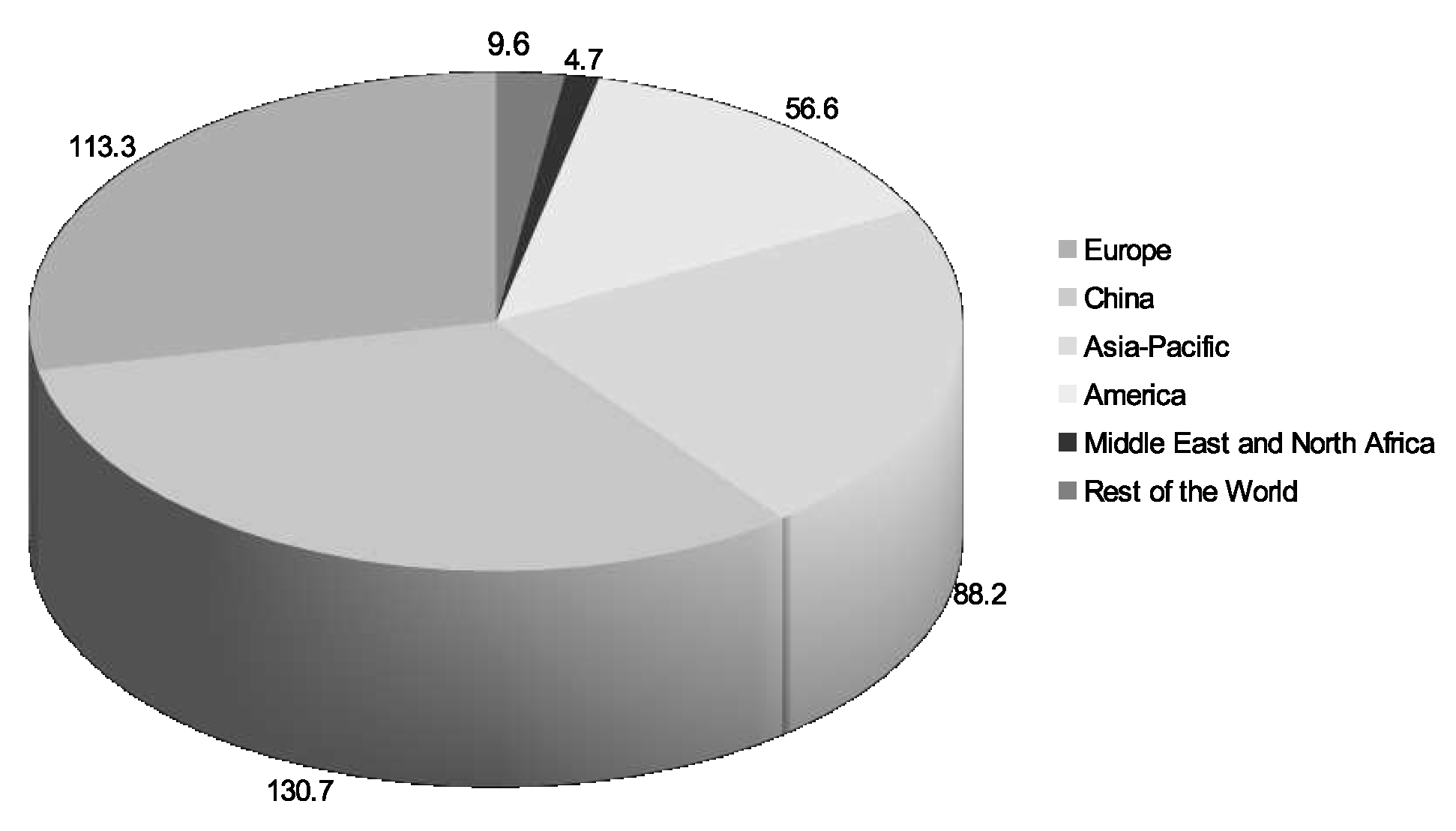
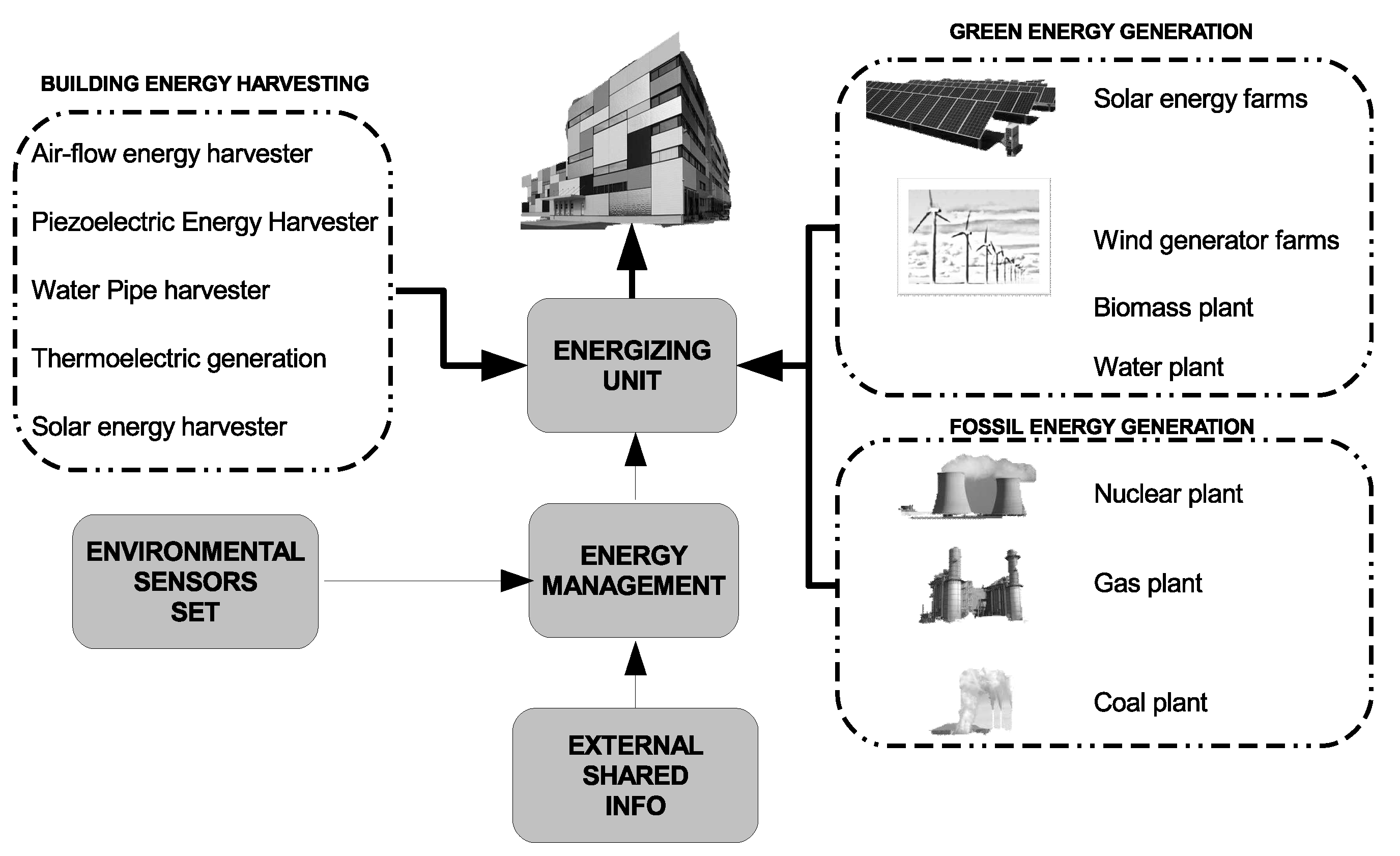
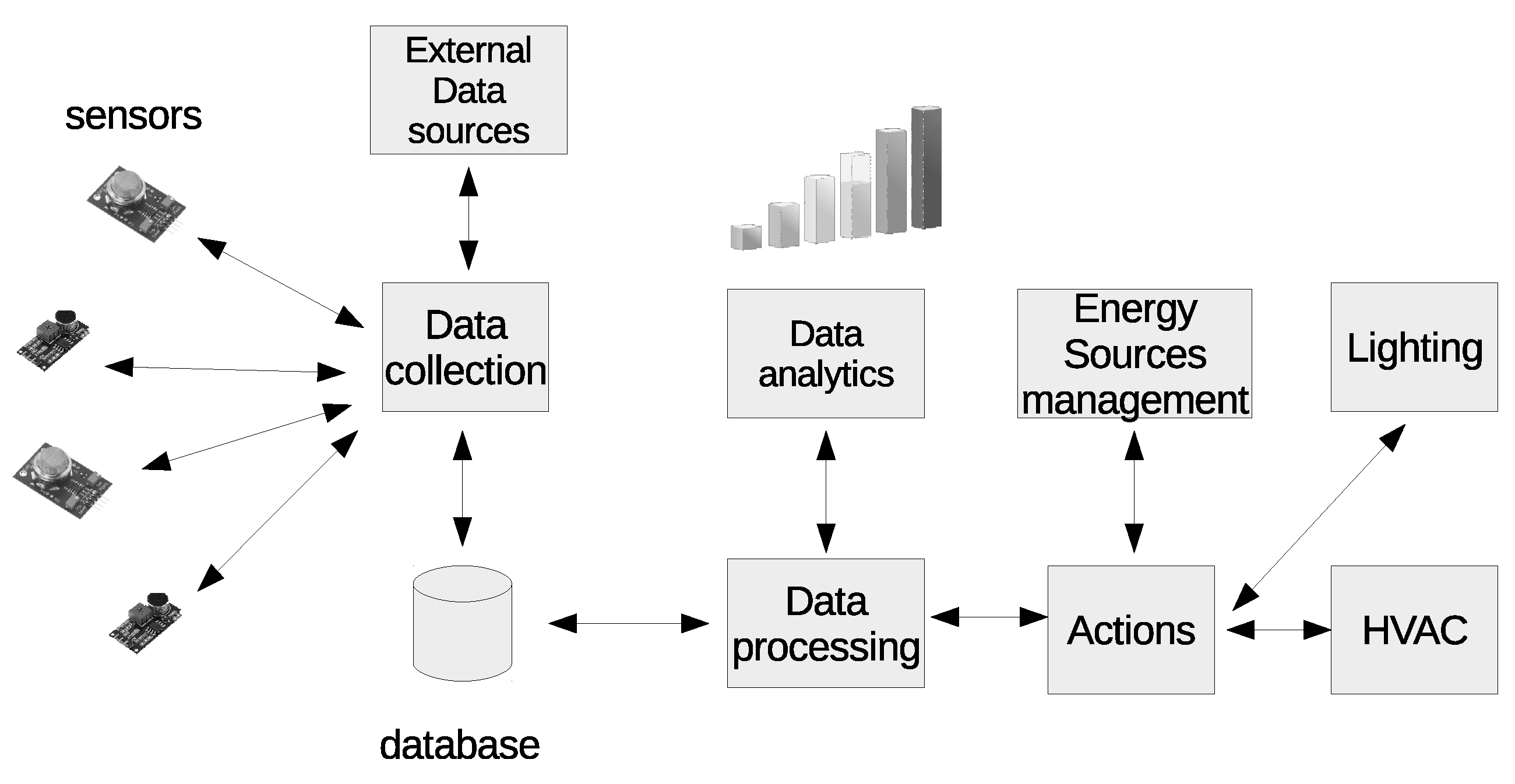

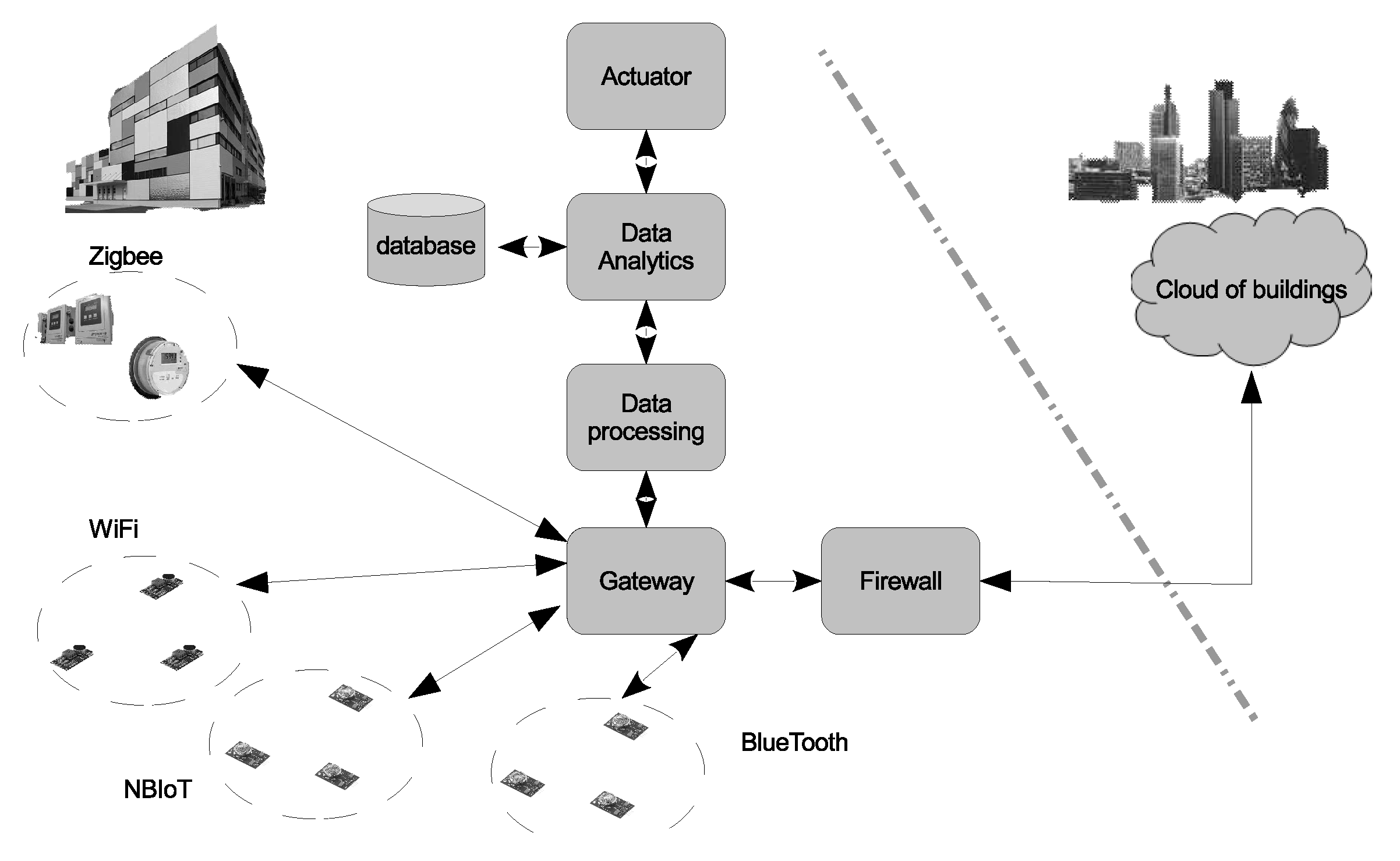
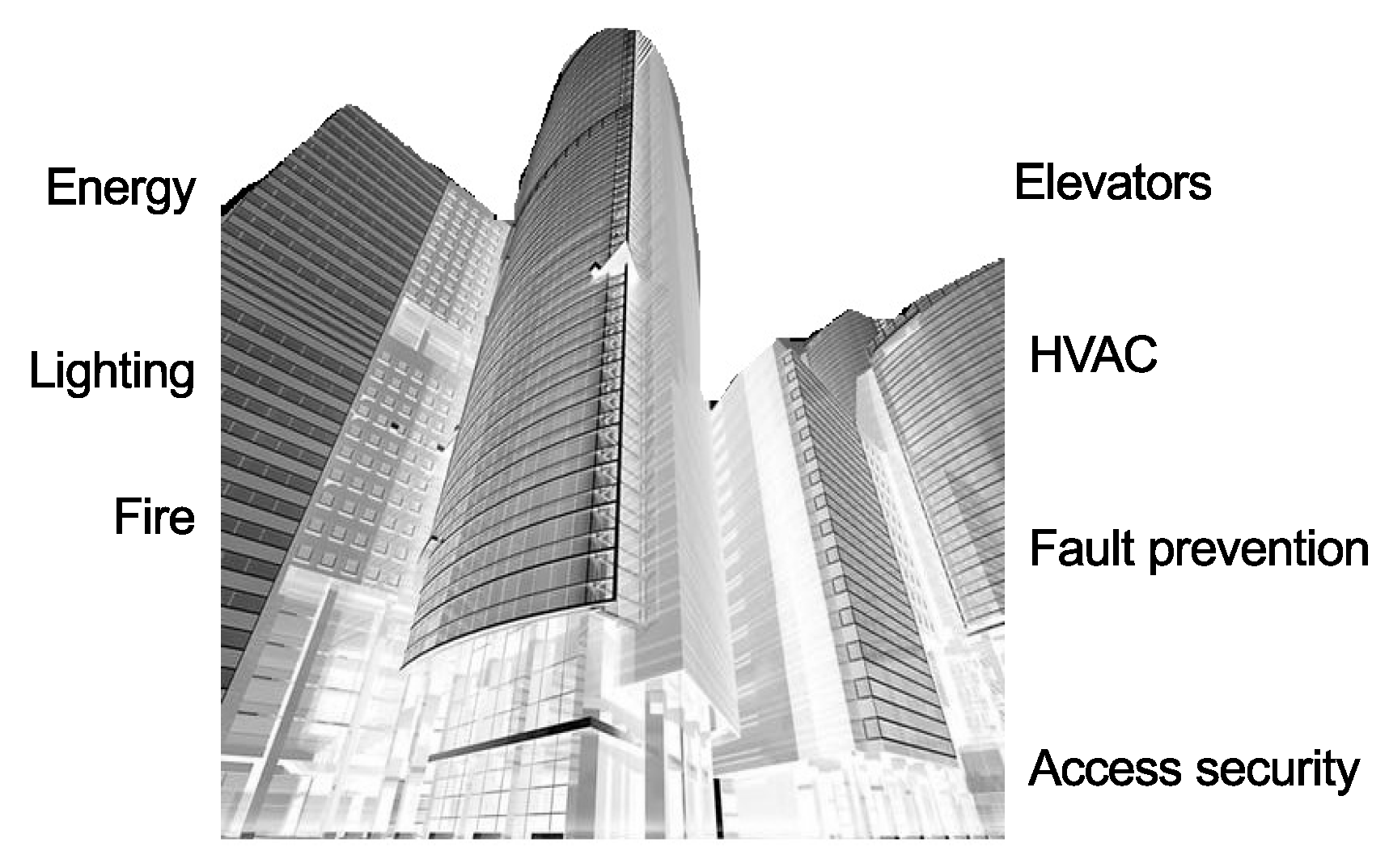
| System | Technology | Energy Savings |
|---|---|---|
| HVAC | Variable speed control | 15–50% of pump or motor energy |
| HVAC | Smart ambient sensing | 5–10% |
| Plug load | Smart plug | 50–60% |
| Plug load | Advanced power strip | 25–50% |
| Lighting | Sensors, actuators smart control | 45% |
| Lighting | Web-based management | 20–30% above controls savings |
| Window shading | Automated shade system | 21–38% |
| Windows hading | Switchable film | 32–43% |
| Windows hading | Smart glass | 20–30% |
| Building automation | Building automation system | 10–25% whole building |
| Analytics | Cloud information-based | 5–10% whole building |
| Building Use | Average Surface m2 | Average Savings (%) |
|---|---|---|
| Education | 10,000 | 11 |
| Office | 5000 | 23 |
| Hotel | 20,000 | 6 |
| Laboratory | 7000 | 40 |
| Hospital | 12,000 | 18 |
| Protocols | UDP/TCP | Architecture | Security and QoS | Header Size (Bytes) | Max Length (.tes) |
|---|---|---|---|---|---|
| MQTT | TCP | Pub/Sub | Both | 2 | 5 |
| AMQP | TCP | Pub/Sub | Both | 8 | - |
| CoAP | UDP | Req/Res | Both | 4 | 20 (typical) |
| XMPP | TCP | Both | Security | - | - |
| DDSv | TCP/UDP | Pub/Sub | QoS | - | - |
| RFID | NFC | WiFi | ZigBee | Blue-tooth | WSN | |
|---|---|---|---|---|---|---|
| Network | PAN | PAN | LAN | LAN | PAN | LAN |
| Topology | P2P | P2P | star | Mesh, star, tree | star | Mesh, star |
| Power | Very low | Very low | Low-high | Very low | low | Very low |
| Speed | 400 kbs | 400 kbs | 11–10 Mbs | 250 kbs | 700 kbs | 250 kbs |
| Range (meters) | <3 | <0.1 | 4–20 m | 10–300 m | <30 m | 200 m |
| Group | Technology | Range |
|---|---|---|
| Short range | RFID (passive) | <3–5 m |
| WiFi (active) | <100 m | |
| Bluetooth/BLE | <100 m | |
| WiFi | <250 m | |
| WirelessHart | <100 m | |
| Zigbee | <100 m | |
| Z-Wave | <100 m | |
| NFC | cm | |
| Long range | LoRa | 10–15 km |
| (E-) GPRS | <15 km | |
| LTE | <11 km | |
| NB-IoT | <11 km | |
| SigFox | <50 km | |
| Weightless | <13 km | |
| LPWAN | 10–15 km | |
| WiMax | <50 km |
| Sector | Application |
|---|---|
| Telematics & Transport | Automotive OEM (original equipment manufacturer) |
| Vehicle Tracking | |
| Container Tracking | |
| Ship Tracking | |
| Fleet Management | |
| OBD (on-board diagnostics) | |
| DVR (digital video recording) | |
| Insurance Box. | |
| Energy & Smart Grid | Electricity Meter |
| Gas Meter | |
| Water Meter | |
| Heat Meter | |
| Smart Grid | |
| Wind energy generation | |
| Solar Panel | |
| Charging Pile. | |
| Smart City & Smart Buildings | Building & Street Lighting |
| HVAC | |
| Lighting, Traffic Light | |
| Lifts monitoring | |
| Digital Signalling | |
| Advertisement led panels | |
| LED illumination | |
| Garbage Bin Monitoring | |
| Smart Parking lots. | |
| Security | Video surveillance: borders, buildings, streets. |
| Building security, monitoring and controls, | |
| Occupancy detection. | |
| Industry | Industrial PDA, Rugged Tablet PC |
| Pipeline Management | |
| UAV (unmanned aerial vehicle), Robotics | |
| Flow Meter, Refrigerator monitoring | |
| Industrial Control and Monitoring | |
| Healthcare and Social System | Personal Tracker, Pet Tracker |
| Wearables | |
| Elderly Monitoring | |
| Remote Medical Equipment | |
| Glucometer, Blood Pressure Monitor | |
| Agriculture | Trail Camera |
| Farm Machinery, Irrigation | |
| Meteorological Station | |
| Wildlife Tracking | |
| Environment Monitoring |
| Protocol | Max. Data Payload (Bytes) |
|---|---|
| ZigBee | 102 |
| 6LoWPAN | 102 |
| Low Power Wi-Fi | 2312 |
| LoRaWAN | 64 |
| BLE | 33 |
| SigFox | 29 |
| NB-IoT | 1600 |
| Z-Wave | 4 to 6 |
| Standard | Frequency | Data Rate | Range | Energy Efficiency | Cost |
|---|---|---|---|---|---|
| 2G/3G | Cellular bands | 10 Mbps | 11 km | low | high |
| LTE Cat 01 | Cellular bands | 1–10 Mbps | 11 km | high | low |
| 6LoWPAN | subGHz and 2.4 GHz | 20–250 kbps | 10–100 m | medium | low |
| Low Power Wi-Fi | subGHz, 2.4, 5 GHz | 0.1–54 Mbps | 100 m | high | low |
| LoRaWAN | subGHz | 50 Kbps | 10–15 km | high | medium |
| Bluetooth/BLE | 2.4 GHz | 1, 2, 3 Mbps | 100 m | high | low |
| SigFox | subGHz | <1 kbps | 50 km | high | medium |
| NB-IoT | Cellular bands | 0.1–1 Mbps | 11 km | medium | high |
| Z-Wave | subGHz | 40 kbps | 100 m | high | medium |
| Weightless | subGHz | 0.1–24 Mbps | 13 km | high | low |
| 802.15.4 | subGHz | 40, 259 Kbps | 15 km | high | low |
| ZigBee | 2.4 GHz | 25 Kbps | 100 m | high | medium |
| WirelessHART | 2.4 GHz | 25 Kbps | 100 m | high | low |
| Thread | 2.4 GHz | 1, 2 Mbps | 10–30 m | high | medium |
| Bluetooth | WiFi | ZigBee | THREAD | |
|---|---|---|---|---|
| Pros | Low energy | Well established standards | Low energy | Low energy |
| Available on mobile devices | Available on mobile devices | Well established standards | Low energy | |
| IPv6 based | Good range | Mesh network | Good range | |
| IPv6 based | Good range | IPv6 based | ||
| Cons | Star network | Star network | Not IP based | Not well established compared to ZigBee |
| Short range | Not available on mobile phones | Not available on mobile phones | ||
| Not mature |
| Sensors | Actuators | Communications | Intelligence | Security | |
|---|---|---|---|---|---|
| HVAC | temperature humidity Air-flow Smart thermostat | Speed control Working cycle Heating control Cooling control | Sensors-to-intelligent system Intelligent system-to-element to control External data sources | Data processing Data Analytics Big Data Artificial intelligence | Firewall Robust protocols |
| Lighting | Light intensity | Switch Light regulator | Sensors-to-intelligent system Intelligent system-to-element to control External data sources | simple command | Firewall Robust protocols |
| Windows | Open/close | Motor | Sensors-to-intelligent system Intelligent system-to-element to control External data sources | simple command | Firewall Robust protocol |
| Lift | Occupancy Stop demand/level # Potential occupants Weight | Motor control | Sensors-to-intelligent system Intelligent system-to-element to control | Data processing Data Analytics Artificial intelligence | Firewall Robust protocols |
| Door | Proximty | Motor Switch | Sensors-to-intelligent system Intelligent system-to-element to control | simple command | Firewall Robust protocols |
| Energy management | Smart metering Energy resources status | Switch | Metering-to-intelligent system | Data processing Data Analytics Big Data Artificial intelligence | Firewall Robust protocols Cryptography |
| Acess security | Cameras Wireless ID fingerprint | Motor | Sensors-to-intelligent system | Artificial intelligence | Firewall Robust protocols Cryptography |
| Fire, wateing … | Smoke Temperature | Switch | Sensors-to-intelligent system intelligent system-to-element to control | Data processing Artificial intelligence | Firewall Robust protocols Cryptography |
| Failure prediction | temperature humidity Air-flow Smart thermostat Smart metering | Stop | Sensors-to-intelligent system intelligent system-to-equipment to control | Data processing Data Analytics Big Data Artificial intelligence | Firewall Robust protocols |
© 2019 by the author. Licensee MDPI, Basel, Switzerland. This article is an open access article distributed under the terms and conditions of the Creative Commons Attribution (CC BY) license (http://creativecommons.org/licenses/by/4.0/).
Share and Cite
Benavente-Peces, C. On the Energy Efficiency in the Next Generation of Smart Buildings—Supporting Technologies and Techniques. Energies 2019, 12, 4399. https://doi.org/10.3390/en12224399
Benavente-Peces C. On the Energy Efficiency in the Next Generation of Smart Buildings—Supporting Technologies and Techniques. Energies. 2019; 12(22):4399. https://doi.org/10.3390/en12224399
Chicago/Turabian StyleBenavente-Peces, César. 2019. "On the Energy Efficiency in the Next Generation of Smart Buildings—Supporting Technologies and Techniques" Energies 12, no. 22: 4399. https://doi.org/10.3390/en12224399
APA StyleBenavente-Peces, C. (2019). On the Energy Efficiency in the Next Generation of Smart Buildings—Supporting Technologies and Techniques. Energies, 12(22), 4399. https://doi.org/10.3390/en12224399





